clutch YAMAHA DT125R 2002 Owners Manual
[x] Cancel search | Manufacturer: YAMAHA, Model Year: 2002, Model line: DT125R, Model: YAMAHA DT125R 2002Pages: 96, PDF Size: 2.14 MB
Page 6 of 96

EAU00009
TABLE OF CONTENTS
GIVE SAFETY THE RIGHT OF WAY ............... 1-1
DESCRIPTION .................................................. 2-1
Left view ......................................................... 2-1
Right view ....................................................... 2-2
Controls and instruments ............................... 2-3
INSTRUMENT AND CONTROL FUNCTIONS .. 3-1
Main switch ..................................................... 3-1
Indicator and warning lights ............................ 3-1
Speedometer unit .......................................... 3-2
Tachometer .................................................... 3-2
Coolant temperature gauge ............................ 3-3
Handlebar switches ........................................ 3-3
Clutch lever .................................................... 3-4
Shift pedal ...................................................... 3-4
Brake lever ..................................................... 3-5
Brake pedal .................................................... 3-5
Fuel tank cap .................................................. 3-5
Fuel (except for Switzerland and Austria) ...... 3-6
Fuel (for Switzerland and Austria) ................. 3-6
Catalytic converter
(for Switzerland and Austria) ....................... 3-7
2-stroke engine oil .......................................... 3-8
Fuel cock ........................................................ 3-9
Starter (choke) lever ..................................... 3-10Kickstarter .................................................... 3-10
Steering lock ................................................. 3-10
Seat .............................................................. 3-11
Helmet holder ............................................... 3-12
Adjusting the shock absorber assembly ....... 3-12
Carrier .......................................................... 3-14
YEIS handling precautions .......................... 3-14
YPVS ............................................................ 3-14
Sidestand ..................................................... 3-15
Ignition circuit cut-off system ........................ 3-16
PRE-OPERATION CHECKS ............................. 4-1
Pre-operation check list .................................. 4-1
OPERATION AND IMPORTANT
RIDING POINTS ............................................... 5-1
Starting a cold engine .................................... 5-1
Starting a warm engine .................................. 5-2
Shifting ........................................................... 5-2
Recommended shift points
(for Switzerland only) .................................. 5-3
Tips for reducing fuel consumption ................ 5-3
Engine break-in .............................................. 5-4
Parking ........................................................... 5-5
123
45
3MB-9-E8 6/13/01 10:55 AM Page 5
Page 7 of 96

PERIODIC MAINTENANCE AND
MINOR REPAIR ................................................ 6-1
Owner’s tool kit ............................................... 6-1
Periodic maintenance and lubrication chart ... 6-2
Removing and installing cowlings .................. 6-5
Removing and installing panels ...................... 6-7
Checking the spark plug ................................. 6-9
Transmission oil ........................................... 6-10
Coolant ......................................................... 6-12
Changing the coolant ................................... 6-14
Cleaning the air filter element........................ 6-16
Adjusting the carburetor ............................... 6-17
Adjusting the engine idling speed ................ 6-17
Adjusting the throttle cable free play ............ 6-18
Tires ............................................................. 6-19
Spoke wheels ............................................... 6-21
Adjusting the clutch lever free play ............... 6-22
Adjusting the brake lever free play ............... 6-23
Adjusting the brake pedal position ............... 6-23
Adjusting the rear brake light switch ............. 6-24
Checking the front and rear brake pads ....... 6-24
Checking the brake fluid level ...................... 6-25
Changing the brake fluid .............................. 6-26
Drive chain slack .......................................... 6-27
Lubricating the drive chain ........................... 6-28
Checking and lubricating the cables ............. 6-29Checking and lubricating the
throttle grip and cable ................................ 6-29
Adjusting the Autolube pump ....................... 6-30
Checking and lubricating the brake and
shift pedals ................................................ 6-30
Checking and lubricating the brake and
clutch levers .............................................. 6-30
Checking and lubricating the sidestand ....... 6-31
Checking the front fork ................................. 6-31
Checking the steering ................................... 6-32
Checking the wheel bearings ....................... 6-32
Battery .......................................................... 6-33
Replacing the fuse ....................................... 6-35
Replacing the headlight bulb ........................ 6-36
Replacing a turn signal light bulb ................. 6-37
Replacing the tail/brake light bulb ................ 6-38
Supporting the motorcycle ............................ 6-39
Front wheel ................................................... 6-39
Rear wheel ................................................... 6-42
Troubleshooting ............................................ 6-43
Troubleshooting charts ................................. 6-44
MOTORCYCLE CARE AND STORAGE ........... 7-1
Care ................................................................ 7-1
Storage ........................................................... 7-4
TABLE OF CONTENTS6
7
3MB-9-E8 6/13/01 10:55 AM Page 6
Page 13 of 96
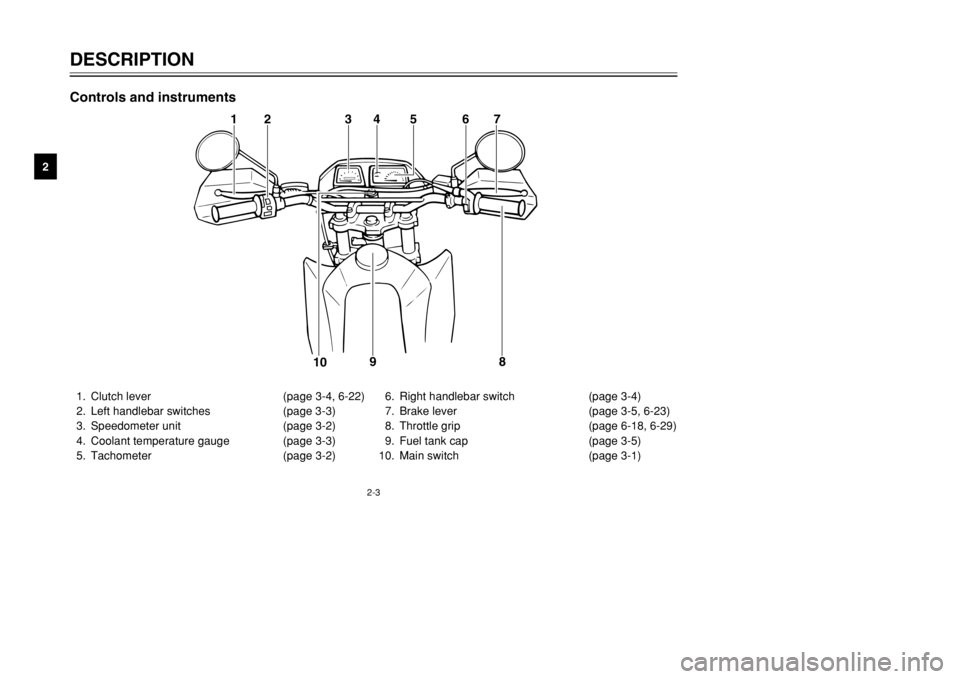
2-3
DESCRIPTION
2
1. Clutch lever (page 3-4, 6-22)
2. Left handlebar switches (page 3-3)
3. Speedometer unit (page 3-2)
4. Coolant temperature gauge (page 3-3)
5. Tachometer (page 3-2)6. Right handlebar switch (page 3-4)
7. Brake lever (page 3-5, 6-23)
8. Throttle grip (page 6-18, 6-29)
9. Fuel tank cap (page 3-5)
10. Main switch (page 3-1)
12 34 5
67
8 9
10
Controls and instruments
3MB-9-E8 6/13/01 10:55 AM Page 12
Page 17 of 96
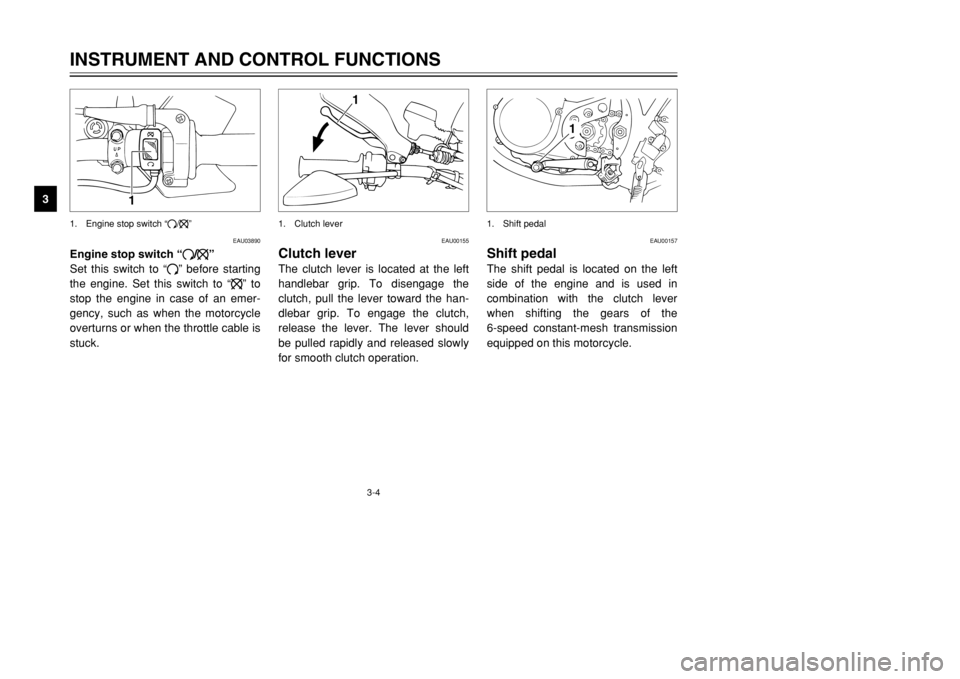
3-4
EAU03890
Engine stop switch “#/$”
Set this switch to “#” before starting
the engine. Set this switch to “$” to
stop the engine in case of an emer-
gency, such as when the motorcycle
overturns or when the throttle cable is
stuck.INSTRUMENT AND CONTROL FUNCTIONS
3
1
1. Engine stop switch “#/$”
EAU00155
Clutch leverThe clutch lever is located at the left
handlebar grip. To disengage the
clutch, pull the lever toward the han-
dlebar grip. To engage the clutch,
release the lever. The lever should
be pulled rapidly and released slowly
for smooth clutch operation.
1
1. Clutch lever
EAU00157
Shift pedalThe shift pedal is located on the left
side of the engine and is used in
combination with the clutch lever
when shifting the gears of the
6-speed constant-mesh transmission
equipped on this motorcycle.
1
1. Shift pedal
3MB-9-E8 6/13/01 10:55 AM Page 16
Page 23 of 96
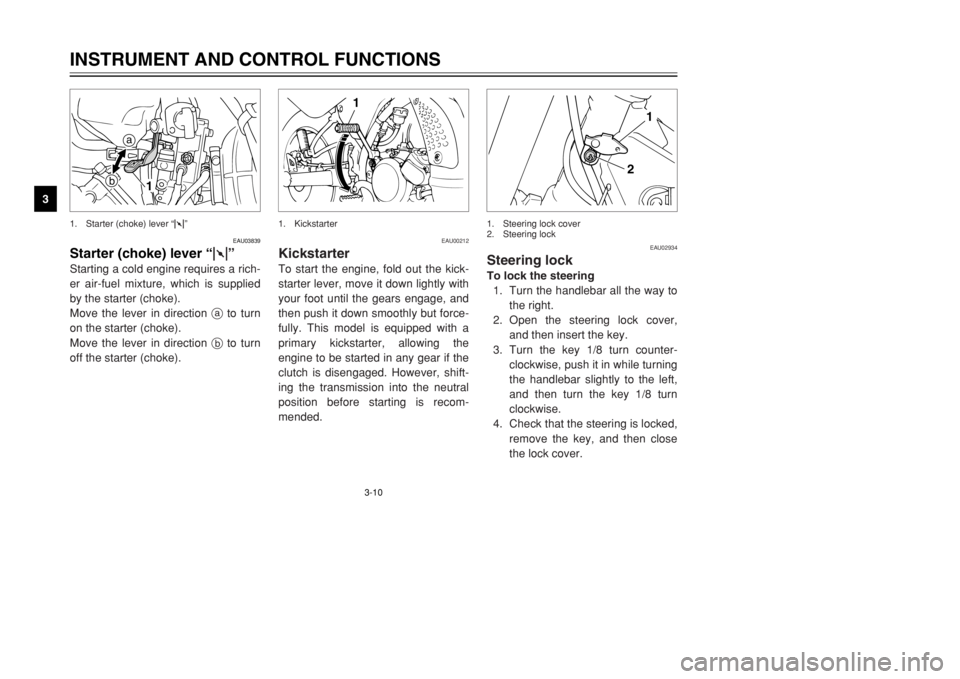
3-10
INSTRUMENT AND CONTROL FUNCTIONS
3
EAU03839
Starter (choke) lever“1”Starting a cold engine requires a rich-
er air-fuel mixture, which is supplied
by the starter (choke).
Move the lever in direction ato turn
on the starter (choke).
Move the lever in direction bto turn
off the starter (choke).
a
b
1
1. Starter (choke) lever “1”
EAU00212
KickstarterTo start the engine, fold out the kick-
starter lever, move it down lightly with
your foot until the gears engage, and
then push it down smoothly but force-
fully. This model is equipped with a
primary kickstarter, allowing the
engine to be started in any gear if the
clutch is disengaged. However, shift-
ing the transmission into the neutral
position before starting is recom-
mended.
1
1. Kickstarter
EAU02934
Steering lockTo lock the steering
1. Turn the handlebar all the way to
the right.
2. Open the steering lock cover,
and then insert the key.
3. Turn the key 1/8 turn counter-
clockwise, push it in while turning
the handlebar slightly to the left,
and then turn the key 1/8 turn
clockwise.
4. Check that the steering is locked,
remove the key, and then close
the lock cover.
2
1
1. Steering lock cover
2. Steering lock
3MB-9-E8 6/13/01 10:55 AM Page 22
Page 30 of 96
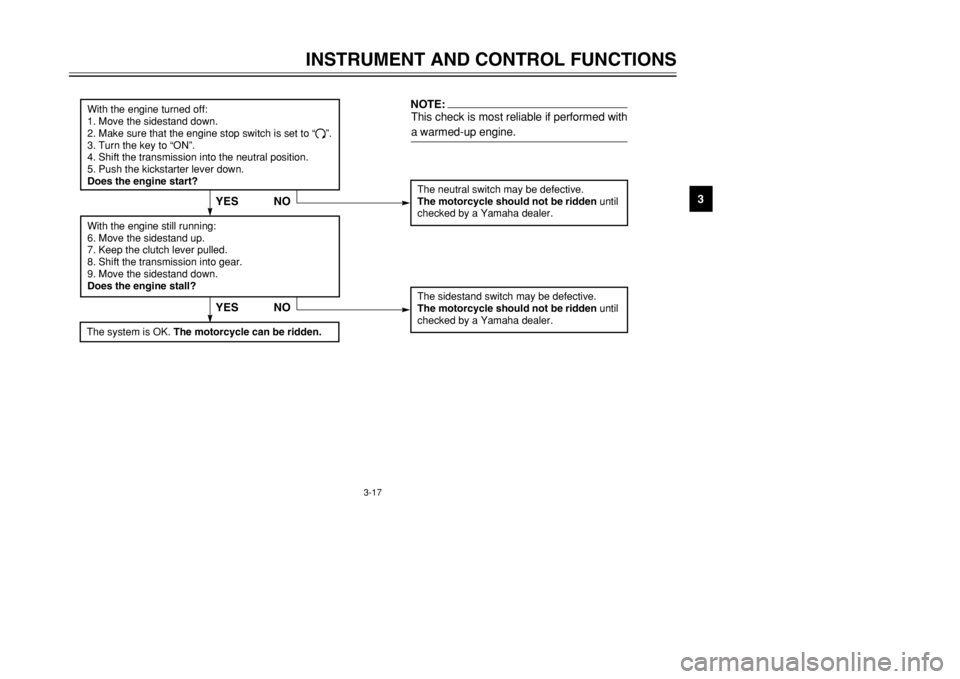
3-17
INSTRUMENT AND CONTROL FUNCTIONS
3
With the engine turned off:
1. Move the sidestand down.
2. Make sure that the engine stop switch is set to “
#”.
3. Turn the key to “ON”.
4. Shift the transmission into the neutral position.
5. Push the kickstarter lever down.
Does the engine start?
The neutral switch may be defective.
The motorcycle should not be ridden until
checked by a Yamaha dealer.
With the engine still running:
6. Move the sidestand up.
7. Keep the clutch lever pulled.
8. Shift the transmission into gear.
9. Move the sidestand down.
Does the engine stall?
The sidestand switch may be defective.
The motorcycle should not be ridden until
checked by a Yamaha dealer.
NO
NOTE:This check is most reliable if performed with
a warmed-up engine.
YESYES NO
The system is OK. The motorcycle can be ridden.
3MB-9-E8 6/13/01 10:55 AM Page 29
Page 32 of 96

4-2
PRE-OPERATION CHECKS
4
Clutch•Check operation.
•Lubricate cable if necessary.
•Check lever free play.
•Adjust if necessary.3-4, 6-22
Throttle grip•Make sure that operation is smooth.
•Check free play.
•If necessary, have Yamaha dealer make adjustment or lubricate.6-18, 6-29
Control cables•Make sure that operation is smooth.
•Lubricate if necessary.6-29
Drive chain•Check chain slack.
•Adjust if necessary.
•Check chain condition.
•Lubricate if necessary.6-7–6-28
Wheels and tires•Check for damage.
•Check tire condition and tread depth.
•Check air pressure.
•Correct if necessary.6-19–6-21
Brake and shift pedals•Make sure that operation is smooth.
•Lubricate pedal pivoting points if necessary.6-30
Brake and clutch levers•Make sure that operation is smooth.
•Lubricate lever pivoting points if necessary.6-30
Sidestand•Make sure that operation is smooth.
•Lubricate pivot if necessary.6-31
Chassis fasteners•Make sure that all nuts, bolts and screws are properly tightened.
•Tighten if necessary.— ITEM CHECKS PAGE
3MB-9-E8 6/13/01 10:55 AM Page 31
Page 34 of 96
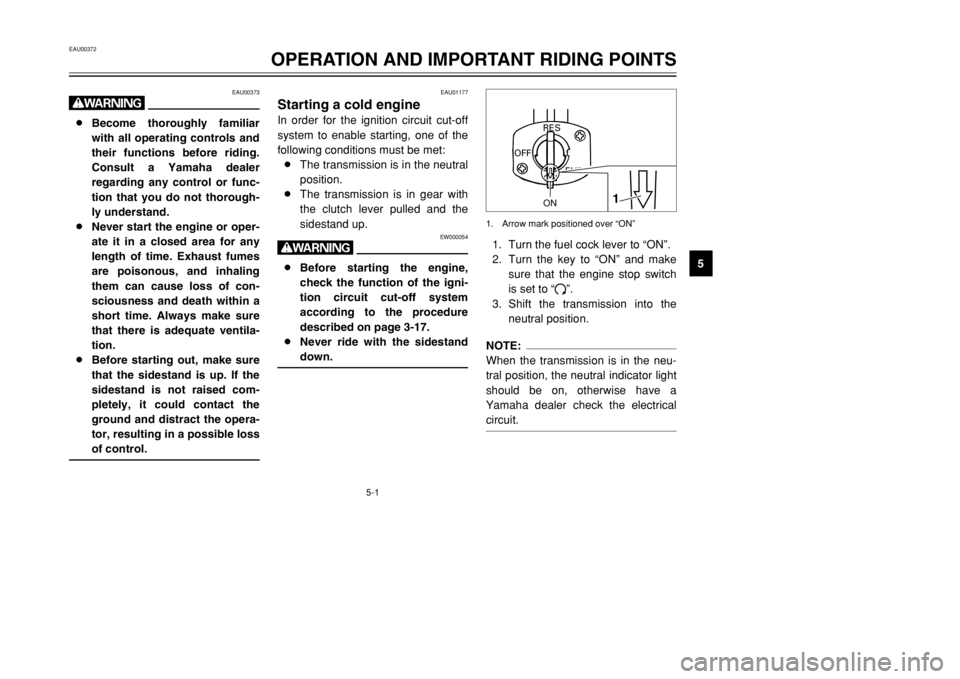
5-1
EAU00372
OPERATION AND IMPORTANT RIDING POINTS
5
EAU00373
w8Become thoroughly familiar
with all operating controls and
their functions before riding.
Consult a Yamaha dealer
regarding any control or func-
tion that you do not thorough-
ly understand.
8Never start the engine or oper-
ate it in a closed area for any
length of time. Exhaust fumes
are poisonous, and inhaling
them can cause loss of con-
sciousness and death within a
short time. Always make sure
that there is adequate ventila-
tion.
8Before starting out, make sure
that the sidestand is up. If the
sidestand is not raised com-
pletely, it could contact the
ground and distract the opera-
tor, resulting in a possible loss
of control.
EAU01177
Starting a cold engineIn order for the ignition circuit cut-off
system to enable starting, one of the
following conditions must be met:
8The transmission is in the neutral
position.
8The transmission is in gear with
the clutch lever pulled and the
sidestand up.
EW000054
w8Before starting the engine,
check the function of the igni-
tion circuit cut-off system
according to the procedure
described on page 3-17.
8Never ride with the sidestand
down.
1. Turn the fuel cock lever to “ON”.
2. Turn the key to “ON” and make
sure that the engine stop switch
is set to “#”.
3. Shift the transmission into the
neutral position.NOTE:
When the transmission is in the neu-
tral position, the neutral indicator light
should be on, otherwise have a
Yamaha dealer check the electrical
circuit.
ON
FUEL
RES
OFF
1
ON
1. Arrow mark positioned over “ON”
3MB-9-E8 6/13/01 10:55 AM Page 33
Page 36 of 96

5-3
OPERATION AND IMPORTANT RIDING POINTS
5
EC000048
cC8Even with the transmission in
the neutral position, do not
coast for long periods of time
with the engine off, and do not
tow the motorcycle for long
distances. The transmission is
properly lubricated only when
the engine is running.
Inadequate lubrication may
damage the transmission.
8Always use the clutch while
changing gears to avoid dam-
aging the engine, transmis-
sion, and drive train, which are
not designed to withstand the
shock of forced shifting.
EAU02937
Recommended shift points
(for Switzerland only)The recommended shift points during
acceleration are shown in the table
below.NOTE:
When shifting down two gears at a
time, reduce the speed accordingly
(e.g., down to 35 km/h when shifting
from 5th to 3rd gear).
EAU00424
Tips for reducing fuel
consumptionFuel consumption depends largely on
your riding style. Consider the follow-
ing tips to reduce fuel consumption:
8Thoroughly warm up the engine.
8Turn the starter (choke) off as
soon as possible.
8Shift up swiftly, and avoid high
engine speeds during accelera-
tion.
8Do not rev the engine while shift-
ing down, and avoid high engine
speeds with no load on the
engine.
8Turn the engine off instead of let-
ting it idle for an extended length
of time (e.g., in traffic jams, at
traffic lights or at railroad cross-
ings).
Shift point
(km/h)
1st→2nd
2nd→3rd
3rd→4th
4th→5th
5th→6th20
30
40
50
60
3MB-9-E8 6/13/01 10:55 AM Page 35
Page 40 of 96

6-2
PERIODIC MAINTENANCE AND MINOR REPAIR
6
NO. ITEM CHECK OR MAINTENANCE JOBODOMETER READING (× 1,000 km)
ANNUAL
CHECK
1 6 12 18 24
1
*Fuel line•Check fuel hoses for cracks or damage.√√√√ √
2 Spark plug•Replace.√√√√ √
3 Air filter element•Clean.√√
•Replace.√√
4*Battery•Check electrolyte level and specific gravity.
•Make sure that the breather hose is properly routed.√√√√ √
5 Clutch•Check operation.
•Adjust.√√√√√
6*Front brake•Check operation, fluid level and vehicle for fluid leakage.
(See NOTE on page 6-4.)√√√√√ √
•Replace brake pads.Whenever worn to the limit
7*Rear brake•Check operation, fluid level and vehicle for fluid leakage.
(See NOTE on page 6-4.)√√√√√ √
•Replace brake pads.Whenever worn to the limit
8*Brake hoses•Check for cracks or damage.√√√√ √
•Replace. (See NOTE on page 6-4.)Every 4 years
EAU03686
Periodic maintenance and lubrication chart
NOTE:
8The annual checks must be performed every year, except if a kilometer-based maintenance is performed instead.
8From 30,000 km, repeat the maintenance intervals starting from 6,000 km.
8Items marked with an asterisk should be performed by a Yamaha dealer as they require special tools, data and
technical skills.
3MB-9-E8 6/13/01 10:55 AM Page 39